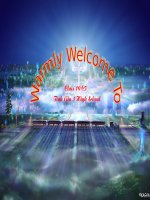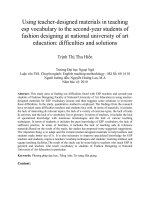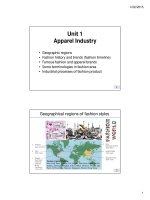FASHION DESIGNING garment technology
Bạn đang xem bản rút gọn của tài liệu. Xem và tải ngay bản đầy đủ của tài liệu tại đây (457.49 KB, 38 trang )
GOVERNMENT OF KERALA
DEPARTMENT OF TECHNICAL EDUCATION
CURRICULUM DEVELOPMENT CENTRE
KALAMASSERY
CURRICULUM OF
PROPOSED KGTE COURSE IN
FASHION DESIGNING &
GARMENT TECHNOLOGY
(Revision 2010)
Formerly KGTE Course in Tailoring Embroidery & Needle Work (TEN)
Prepared at
CURRICULUM DEVELOPMENT CENTRE, KALAMASSERY
2
CONTENTS
SL.
NO.
1.
CONTENT
PAGE NO.
Rules and Regulations
3-6
st
I year Fashion Designing & Garment Technology
Subjects of study, scheme of examination & evaluation
Textile Science
FDGT-11
8-11
4.
Pattern Making
FDGT-12
12-13
5.
Basic Garment Construction
FDGT-13
14-15
6.
Surface Ornamentation
FDGT-14
16-17
7.
Fashion Illustration
FDGT-15
18
8.
Market Analysis
nd
2 year Fashion Designing & Garment Technology
Subjects of Study, Scheme of examination &Evaluation
Fashion Business & Fundamentals of Apparel Production
FDGT-16
19
FDGT-21
21-22
12.
Garment Manufacturing Technology (GMT)
FDGT-22
23-24
13.
Advanced Garment Construction
FDGT-23
25-26
14.
Value Addition Techniques
FDGT-24
27
15.
Computer Aided Fashion Design
FDGT-25
28-31
16.
Soft Skills
FDGT-26
32
17.
Suggested Reference Books
33
18.
Annexure I
34
19.
Scheme of Examination
RESOURCE PERSONS CONTRIBUTED TO THE
DEVELOPMENT OF FASHION DESIGNING & GARMENT
TECHNOLOGY CURRICULUM
2.
3.
9.
10.
20.
3
7
20
35-36
37
RULES AND REGULATIONS OF THE CERTIFICATE COURSE IN
FASHION DESIGNING & GARMENT TECHNOLOGY (FDGT)
UNDER THE STATE BOARD OF TECHNICAL EDUCATION, KERALA
Course Title
The Course title shall be “Fashion Designing & Garment Technology”.
Duration of the Course
The duration of the course shall be of two Academic years.
Medium of Instruction
The medium of instruction shall be Malayalam.
Eligibility for Selection to the Course
The candidates for admission shall be required to have completed the Xth Standard
examination conducted by the Board of Public Examinations, Kerala state or any
other examination recognized by the Board of Public Examinations, Kerala state
with/with out, eligibility for Higher Education.
Age Limit
Applicants seeking admission to the course should have completed 15 years of age
on 31st May of the relevant academic year.
Gender Considerations
Admission may be extended to Boys and Girls. But the admission to Boys is limited
to a maximum of 25% of the total sanctioned intake at a centre. Admission to boys
and girls shall be from a common rank list.
Registration
Every student admitted to the course shall seek Registration from the Board of
Technical Examinations, with relevant documents, in the prescribed form. The
registration shall be valid for a maximum of 5 years.
Instructional Duration in an Academic year.
The academic year shall consist of a minimum of 36 weeks of instruction including
intervening holidays, but excluding the period of examination and study holidays.
The course shall follow, annual pattern with End of the Year examinations
conducted by the Board of Technical Examinations, Kerala.
There shall be 7 instructional periods of 55 minutes duration per day, and there
shall be 5 working days per week form Monday to Friday and there by 35 periods
per week.
4
Minimum Attendance Required for obtaining eligibility to appear for the
Examination
A candidate must secure a minimum of 80% attendance in each year, in order to
secure eligibility to appear for each End of the Year Examination.
In the case of those students with 65% or more attendance, but could not attain
80% attendance due to medical reasons, the Principal / Head of the institution, at
his / her discretion, may grant the eligibility to appear for the examination, subject
to the remittance of the “Condonation Fee”, fixed by the Government from time to
time.
Students who have secured less than 65% attendance are not eligible to apply for
“Condonation”, and will not be allowed to appear for the examination under any
circumstance.
Students who have shortage of attendance, but not condoned, are not eligible to
appear for the end of the year examination. They may seek readmission and
repeat the classes. Application for readmission shall be entertained only for
genuine cases on medical grounds and in doubtful cases, Principal / Head of
Institution shall seek report from the medical board.
Condonation by the Principal / Head of Institution shall be permitted only once in
the entire course.
If condonation is required for a second time, it should be obtained from the Joint
Director of the respective Regional Directorate / Directorate of Technical Education
under which the institution is situated, on the recommendations of the Principal /
Head of Institution.
Continuous Absence, Removal From Rolls and Readmission.
A student who is absent from the class for a continuous period of 15 working days
will be removed from the rolls. Such students shall seek readmission in the same
academic year, submitting application to the Principal / Head of Institution citing
genuine reasons. Such students should remit the required fee for availing
readmission. Permission for readmission shall be granted only on genuine cases
and only if the student can attain the minimum of 65% of prescribed attendance for
the academic year. Otherwise the student will not be allowed to seek readmission
in the current academic year and the student will have to seek readmission in
subsequent years with in the validity of the registration. Such students seeking
readmission in the subsequent years should get the permission from the Joint
Director of the respective Regional Directorate / Directorate of Technical Education
under which the institution is situated.
Scheme of Evaluation
The scheme of evaluation shall consist of,
i. Internal Assessment.
ii. End of the Year examination in Theory & Practical subjects.
The maximum marks for End of the year examinations, and internal Assessment,
both for Theory and Practical Subjects shall be 75 and 25 respectively except for
Market analysis and Soft skills, for which only Internal Assessment shall be
conducted.
The total marks for each year shall be 550.
All the End of Year examinations will be of 3 hour duration.
5
Award of Internal Assessment Marks
In respect of theory subjects, the award of Internal Assessment marks will be on a
Continuous Evaluation method, based on tests, assignments and attendance in
the proportion of 40% for Tests, 40% for Assignments and 20% for Attendance.
There shall be a minimum of 3 Tests and 3 Assignments and all the 3 tests and 3
Assignments are considered for the award of Internal Assessment marks.
Split up of Internal Assessment marks.
Attendance
S. No
Percentage of
Attendance*
1
2
3
4
5
90 and above
80 to 89
70 to 79
65 to 69
Less than 65
Marks to be awarded
(Computed for 5
marks)
5
4
3
2
1
Practical
S. No
1
Criteria Component
Marks to be awarded
Observation Note /
20%
Rough Record / Album
2
Fair Record / Album
20%
3
Attendance*
20%
4
Test
40%
* Percentage of attendance for that particular subject is taken.
Faculty concerned will maintain record of all details regarding the Attendance and
internal Assessment marks awarded, in the prescribed log book. It shall be published
in the last week of the academic year. The student can represent their grievances, if
any, in respect of marks warded to the Principal / Head of the Institution for redressal.
The students are required to keep a record of all their laboratory exercises performed
in the form of a laboratory record. For some subjects, students are required to prepare
albums. Scheme of Examinations shall specify the subjects for which Practical for
which Record and/or Album is required.
The Record / Album has to be certified by the Senior Instructor of the institution.
No student will be permitted to attend the practical exam with out presenting the
bonafide Record / Album.
6
End of the year Examination
In each theory subject, there will be and end examination in each year conducted by
the Board of Technical Examinations as per the pre announced notification of
examination. The time table for the examination will also be published ahead of its
conduct.
There will not be any separate supplementary examination.
The question paper for each theory paper will consist of 2 parts,
PART A – is for a maximum of 15 marks, consisting of 10 Fill in the blanks questions
and 5 questions for which answers are to be given in 1 or 2 sentences. Each question
in Part A shall carry 1 mark.
PART B – consists of 10 structured essay type questions of 12 marks each, with 2
questions from each of the 5 units in a subject. Students will have to attend One
question from each unit to score a maximum of 60 marks.
Part A and Part B will be given together in one question paper.
For practical examinations, the Board of Technical Examinations shall appoint
examiners, who will set a question paper consisting of practical exercises. This will be
used for that practical subject. Valuation shall be done jointly by Internal & External
Examiners at the time of examination.
Minimum Marks for a pass
A candidate must secure a minimum of 40% marks in thee End of the Year
examination, in Theory and Practical for a pass in each subject. There will be no
minimum for pass in the Internal Assessment, but the total marks of the End of the
year examination and the Internal Assessment should not be less than 40% for a pass
in each subject.
How ever for Market analysis and Soft Skills, evaluation is through Internal
Assessment alone and no End of the year examination is conducted, student should
score a minimum of 40% of marks for a pass. Otherwise He / She should take
readmission to complete the academic requirements in these subjects.
Promotion to the Second year
A candidate shall be promoted to the second year, if He/She has attended the First
year and has fulfilled the conditions of attendance.
Classification of Successful Candidates
A candidate will be declared to have passed the course only if he / she has secured a
pass in all the theory and Practical Subjects including Market analysis and Soft skills,
within the validity of his/her registration.
There shall be two classifications of passed candidates,
First Class.
Second Class.
A candidate will be declared to have passed the course in First Class if he / she
secures a pass in all the subjects, with an aggregate minimum of 60% with in the
normal duration of the course, that is 2 academic years after the registration.
All other successful candidates will be declared to have passed the course in Second
Class.
7
Ist year Fashion Designing & Garment Technology
(Certificate Course)
FDGT13
Basic garment
construction
04
FDGT14
Surface ornamentation
techniques
05
FDGT15
Fashion Illustration
06
FDGT16
Market Analysis
--
25
75
7
7
3
Album
25
9
9
3
Record &
Album
25
8
8
3
5
5
3
--
--
Total
Album
Album
Report
------
---
Total
3
--
Practical
6
Practical
Theory
03
Pattern making
Internal
FDGT12
6
Documents
02
Textile science
Evaluation (marks)
Duration
FDGT11
Subject
Examination
Total
01
Periods/week
Theory
Sl.
No
Subject code
Subjects of study, scheme of examination & evaluation
100
75
100
75
100
25
-------
75
100
25
---
75
100
50
----
----
50
550
8
SUBJECT TITLE
SUBJECT CODE
PERIODS PER WEEK
PERIODS PER YEAR
TOTAL MARKS
:
:
:
:
:
Textile Science
FDGT 11
6
216 (6x36)
100
TIME SCHEDULE
UNIT
I
II
III
IV
V
TOPICS
Introduction to Textiles
Finishing Techniques
Traditional Textiles
Sewing machine
Fullness in garments
Total
PERIODS
40
44
40
46
46
216
OBJECTIVES
The student will be able to:1.Understand the different types of fibres used for manufacturing yarn and fabric
& their properties
2.Process of formation of yarn & fabric and their important features
3.The treatment given to improve the aesthetic value of fabrics
4.The care of fabrics
5. Sewing practice and body measurements.
6. Understand the techniques for imparting fullness to the fabrics
Unit I
Introduction to textiles
Fibre
I.1.0
I.1.1
Classification of fibres - Natural, man made and regenerated
Identification, properties and uses of different textile fibres – cotton, silk, linen, wool,
rayon, polyester, nylon etc.
Yarn
1.2.0 Process of yarn formation – fibre to yarn- yarn and their properties – spinning,
count-twist- carded- combed- blended yarn-blend ratio, classification of yarnsimple, fancy, novelty yarns, etc.
1.2.1 Sewing thread and properties –singeing, waxing, ply, doubling.
9
Fabric
1.3.0 Method of fabric construction, weaving, knitting, felting- warping, sizing, weft
winding-handloom, power loom, modern loom-shedding, picking, beating.
1.3.1 Fabric structures - plain weave and modifications-basket weave, rib weave, extra
warp, extra weft-twill weave and its modifications – herringbone, high angled, low
angled, right, left, satin weave, sateen weave, etc.
1.3.2 Fabric particulars:
Warp, weft, count of yarn, EPI, PPI, cloth cover, selvedge –open ,closed- design,
width of cloth, drape, reed, reed count
1.3.3 Cloth defects - missing ends, crack, stains, processing defects.
Unit II
Finishing Techniques
.
2.1.0 Finishing process – singing, scouring, bleaching, mercerising, sizing, sanforising,
dyeing, printing, calendaring, shrinking, weighing, napping, glazing, embossing,
moireing.
2.1.1 Textile printing – methods – screen, block, stencil, spray, roller printing- styles of
printing - direct, discharge, resist.
2.1.2 Textile dyeing – methods and styles – stock dyeing, solution dyeing, yarn dyeing,
piece dyeing, product dyeing etc. – common dyes – direct, acid, basic, vat etc.
2.1.3 Clothing care
Stains removal, laundry
Unit III
Traditional textiles
Dyed fabrics
Woven fabrics
carpet weaving
Printed fabrics
Hand painted fabric
Hand embroidered fabric
embroidery
:Ikat, Bandhni
:Kancheepuram brocades, muslin, Kerala fabrics,
:Sanganer block printing
:Kalamkari, Madhubani
:Bengalkantha, Phulkari, Lucknow chicken, Kutch
Note:Emphasis to be given with classification on embroidered, dyed, printed and
woven fabric. Every student has to maintain swatch (sample collection) folder.
Survey of trims and accessories, different types of fabrics and threads
10
UNIT IV
Sewing Machine.
Introduction to sewing machine
4.1.0 Importance of machine practice including. Machine parts, Attachments, common
problems and remedies while sewing, maintenance of sewing machine. Defect in
stitch formation, causes and remedies, attending most commonly occurring
mechanical defects.
Equipments and Requirements: 4.1.1 Equipments for garment construction, cutting tools, measuring tools, Needles
and threads for sewing, materials for fastening. (Hooks and eyes, Buttons, Zip
fastener)
Knowledge of embroidery tools:4.1.2 Blotting paper, carbon paper, cartridge paper, compasses, drawing pins, drawing
board, fine brush, embroidery frames, iron and ironing board, needles, pattern
paper, pins, bodkin, small scissors, thimbles, stiletto, tracing paper, tracing wheel,
forceps.
Preparing and finishing:4.1.3 State different kinds of transferring methods according to the type of fabrics carbon method, pouncing method, direct method.
UNIT V
Fullness in Garments
5.1.0 Seams
Classification of seams-description and construction procedure-relative merits
and demerits of seam type, seam finishes, French seam, Turned and stitch, Flat
fell, Mock French. overcast, herringbone.
5.1.1 Pleats
Knife pleat, Box pleat, inverted pleat, pleat with separate colour underlay.
5.1.2 Ruffles
Circular ruffles, Straight ruffles
Tucks
5.1.3 Body Measurements
Method of taking body measurements, relation of measurements, scale of
measurement, measurement chart (children, ladies, gents)
11
Elements of Design
5.1.4 Basic Design – Colour Theory, Colour Wheel, Colour Harmony.
5.1.5 Elements & Principles of Design – Line, Space, Shape, Form, Texture, Colour &
balance, Proportion, Rhythm, Emphasis, Unity, Harmony
5.1.6 Measuring Techniques
Introduction, Standard measurement chart
12
SUBJECT TITLE
SUBJECT CODE
PERIODS PER WEEK
PERIODS PER YEAR
TOTAL MARKS
: Pattern making
: FDGT 12
: 7
: 252 (7x36)
: 100
TIME SCHEDULE
TOPICS
PERIODS
Basics of pattern Making
Anatomy for pattern making
Drafting
Neck& Sleeve styles
Skirt variation
Fullness
Different seam finish
252
OBJECTIVES
To enable students to select design and draft pattern in various garments based on
body measurements to develop basic block for construction
Basics of pattern Making
Pattern-making tools, Pattern lay out, rules in pattern lay out, rules in pattern
layout, common method of lay out, special lay out, marker plan and efficiency,
Anatomy for pattern making
Proportion and disproportion of human figure types.
Drafting
Drafting the basic pattern set:
a. Basic bodice – front and back
b. (Both in ¼ and full scale)
c. Basic skirt-Front and back
d. Basic sleeve
Drafting garments
Basic kameez- Front and back, Basic kameez sleeve
Neck& Sleeve styles
Drafting Sleeves
Bell sleeve, Petal sleeve, Flared sleeve, Puff at hem, Puff at cap, Puff at hem
and cap,
Leg‘O’Mutton (1/2 scale and full scale)
13
Necklines
Basic Neck lines.
Collars
Mandarin (Chinese/Stand), Shirt, Sailor, Peter pan collar
Skirt variation.
a. A line b. Circular
c. Gathered d. Wrap over
Fullness
Pockets
Darts
Pleats
Tucks
Different seam finish
French seam, turned and stitch, flat felled (run and fell), Mock French
14
SUBJECT TITLE
SUBJECT CODE
PERIODS PER WEEK
PERIODS PER YEAR
TOTAL MARKS
:
:
:
:
:
Basic Garment Construction
FDGT 13
9
324 (9x36)
100
TIME SCHEDULE
TOPICS
PERIODS
Sewing Machine
Body Measurements
Seams
Fullness in garments
Neck Styles
Sleeves
Openings &Fastenings
Garment Stitching & Finishing
324
OBJECTIVES
1.
2.
3.
4.
To familiarize with the basic features of a garment and construction particulars
Sewing practice and body measurements
Understand the techniques for imparting fullness to the fabric
Various openings and fastenings
Introduction to sewing machine
Importance of machine practice including. Machine parts, Attachments, common
problems and remedies while sewing, maintenance of sewing machine. Defect in
stitch formation, causes and remedies, attending most commonly occurring
mechanical defects.
Equipments and Requirements: Equipments for garment construction, cutting tools, measuring tools, Needles
and threads for sewing, materials for fastening. (Hooks and eyes, Buttons, Zip
fastener)
Stitching practice:Straight lines, broken lines, waves, corner lines, circles. (in paper & fabric).
Submit assignment
Body Measurement:Method of taking body measurements, relation of measurements, scale of
measurement, measurement chart (children, ladies, gents)
15
Seams:Classification of seams-description and construction procedure-relative merits
and demerits of seam type, seam finishes, French seam, Turned and stitch, Flat
fell, Mock French. overcast, herringbone.
Pleats
Knife pleat, Box pleat, inverted pleat, pleat with separate colour underlay.
Ruffles
Circular ruffles, Straight ruffles
Tucks
NECK STYLES.
Necklines
Glass neck, boat neck with keyhole, sweet heart, ‘U’ neck, ‘V’ neck & jewel neck in
12”x12” size
Neckline Finishing
Shaped facing, Piping, Binding-single binding, double binding, corded piping,
finishing with frills.
Collars
Mandarin collar, peter pan collar, shirt collar, sailor collar, tie collar
Sleeves
Puff at hem, puff at cap, both sides (3 types) bell sleeve, petal sleeve, flared
sleeve, bishop sleeve, cap sleeve.
Openings&Fastenings
Placket
Front placket, side, continuous, fly packet
Zip Attachment
Centre application, over lapping, invisible zip attachment.
Garments Stitching And Finishing
Basic bodice with set in sleeve construction-front-2 dart and back 4 dart (2 in
shoulder)
A line frock, basic skirt, salwar, basic kameeze with plain sleeve shirts, lining,
interlining, elastics, buttons, labels
16
SUBJECT TITLE
SUBJECT CODE
PERIODS PER WEEK
PERIODS PER YEAR
TOTAL MARKS
:
:
:
:
:
Surface Ornamentation
FDGT 14
8
288 (8x36)
100
TIME SCHEDULE
TOPICS
PERIODS
Embroidery tools
Out line stitches
Chain stitches
Border stitches
Marking stitches
Decorative stitches
288
OBJECTIVES
Stitches for surface adornment and their suitability to the various designs.
Knowledge of embroidery tools:Blotting paper, carbon paper, cartridge paper, compasses, drawing pins, drawing
board, fine brush, embroidery frames, iron and ironing board, needles, pattern
paper, pins, bodkin, small scissors, thimbles, stiletto, tracing paper, tracing wheel,
forceps.
Preparing and finishing:State different kinds of transferring methods according to the type of fabrics carbon method, pouncing method, direct method
Embroidery
Out line stitches
Even and Uneven running stitch.
Back stitch
Stem stitch
Chain stitches
Chain stitch
Magic chain
Twisted chain
Broken chain
Lazy daisy stitch
Cable chain
Blanket stitch &variations.
Feather stitch &variations.
Wheat
17
Border stitches
Herring bone stitch
Closed herring bone
Chevron stitch
Hole bean
German knot
Mallik
Marking stitches
Cross stitch
Star stitch
Durban or queen stitch
Decorative stitches
French knot
Bullion knot
Couching & overcastting.
Satin stitch
Long and short
Fern
Eyelet
Loop
Wave
Coral
Spider web & variations.
Rumanian
Mirror work
Bead work
Leaf(fishbone)
Related experience and practices
Students should maintain a record having at least one sample of each stitch.
18
SUBJECT TITLE
SUBJECT CODE
PERIODS PER WEEK
PERIODS PER YEAR
TOTAL MARKS
:
:
:
:
:
Fashion Illustration
FDGT 15
5
180 (5x36)
100
TIME SCHEDULE
TOPICS
PERIODS
Elements of Design
Fashion Illustration
Spec Drawing
180
OBJECTIVES
To understand the colour theory & the elements and principles of design
To understand the principles of draping garments
Elements of Design
Basic Design – Colour Theory, Colour Wheel, Colour Harmony.
Elements & Principles of Design – Line, Space, Shape, Form, Texture, Colour &
balance, Proportion, Rhythm, Emphasis, Unity, Harmony
Fashion Illustration
•
•
•
•
•
•
Basic 8 head croqui & basic 10 Head croqui-Frontal
Fashion frontal face-eyes, nose, ears, mouth and head
Drawing different Hair Styles
Fleshing croqui
Principles of draping garments on Croqui
Colour Rendering of Solids, Prints, Checks, Stripes, Floral, dots, Denim, Satin, Silk,
Velvet, Chiffon & Lace
Spec Drawing
•
Necklines, Collars, Sleeves, Cuffs, Hemlines of Skirts & Blouses, Pants, Pockets,
Gathers, Frills, Pleats
NOTE: Students to maintain a record of all works done. Rendering in the following
mediums to be made compulsory: Pencils, Colour pencils, Poster colour &
sketch/Felt pens.
19
: Market Analysis
: FDGT 16
: ---: ----: 50
SUBJECT TITLE
SUBJECT CODE
PERIODS PER WEEK
PERIODS PER YEAR
TOTAL MARKS
Market analysis is intended for the students to get information on the various accessories and
equipments available in the market used for garment manufacturing.
The class room
sessions can give only a brief description of the basic material used for the trade. Detailed
information on various materials available for manufacturing and adornment can be gained
through survey of the market.
The survey is to be conducted during out off the class.
Students are required to survey the market and collect maximum samples as far as possible.
They are to prepare a catalogue that consists of samples along with a report describing their
practical applications. Evaluation to be done on the basis of collection of samples and
description of their features and applications. Collection of samples/details of following items
are suggested:a) Different types of sewing threads – their use according to materials.
b) Cloth samples of various weaves, materials, embroidery, design etc.
c) Sewing needles – various grades
d) Different types of sewing machines – single needle, double needle etc.
e) Trimming materials – Different fasteners used in dress making trade, hooks, eye,
zips, buckles, buttons, elastics etc, their materials, size, specifications etc.
f) Lining, interlining, interfacing & stiffening materials.
g) Button sewing machine, button hole stitching machine, over lock machine – three
threads, five threads etc, cutting machine.
h) Iron, Presser board, Cutting machine etc.
20
2nd year FASHION DESIGNING & GARMENT TECHNOLOGY
03
04
FDGT22
FDGT23
Advanced garment
construction.
Value addition techniques
FDGT24
05
FDGT25
06
FDGT26
Computer aided fashion
designing(CAFD)
Soft skills
6
6
3
Album
9
9
3
Album&
Record
8
8
3
Album
5
5
3
Record
25
1
-
--
50
1
Total
21
---
25
75
25
25
25
----
Total
3
Practical
Documents
Practical
6
---
Theory
6
Internal
Fashion Business and
fundamentals of apparel
production
Garment Manufacturing
technology (GMT)
Evaluation (Marks)
Duration
02
FDGT21
Subject
Examination
Total
01
Periods/Week
Theory
Sl.
No
Subject code
Subjects of Study, Scheme of examination &Evaluation
---- 100
75
100
75
100
75
100
----
75
100
---
--
50
------
550
SUBJECT TITLE
SUBJECT CODE
PERIODS PER WEEK
PERIODS PER YEAR
TOTAL MARKS
: Fashion Business & Fundamentals of
Apparel Production
: FDGT 21
: 6
: 216 (6x36)
: 100
TIME SCHEDULE
UNIT
I
II
III
IV
V
TOPICS
Introduction to Fashion Business
Fashion & Customer
Fundamentals of Apparel Production
Finishing Process
Computer theory
Total
PERIODS
40
44
44
44
44
216
OBJECTIVES
To provide a brief knowledge on fashion world and the factors that has an influence
on it. Knowledge on apparel production and various finishing process
Unit I
Introduction to Fashion Business
1.1.0 Purpose of clothing - Protection, Communication & Decoration
Indian & International Trend setting Fashion Designers. (Done as Project by
students’
group & to be presented in class)
Factors affecting Fashion – Effects of Social, Cultural, Political & Artistic.
1.1.1 Technical Terms:Paper pattern, Layout, inlay, arm hole, skirt, hem, hem line, trimming, lining,
interlining,
finishing, leg length, opening, placket, bias band, slit, vent, pitch point, facing,
overlapping,
velt, turning, alteration, fork, seat, jetting, fly, notches, band, flap, tape, dummy,
balance mark.
UNIT II
Fashion & Customer
2.1.0 Fashion Terminology
Fashion forecasting, International fashion centres, Fashion markets, Seasons of
fashion, clothing categories in Men’s wear, Women’s wear & kid’s wear.
2.1.1 Consumer behaviour - Customer profile. Defining the customer by: Sex, Age,
Size, Season, and Economic status, Location
Market research - Methods & Data analysis
22
Unit III
Fundamentals of Apparel Production
3.1.0 The clothing industry – Infrastructure & profile of a clothing factory - Introduction to
functions of various Departments.
3.1.1 Production process – Inspection of Fabric & its control, Various methods of
spreading fabric,
Importance of Marker, Understanding of patterns & methods of
laying patterns, Yardage control in cutting room, Types of cutting machine
UNIT IV
Finishing Process
4.1.0 Types of fusing – Operation of fusing machine, Quality aspects in fusing, Advantage
of using
fusible interlinings, requirement of fusing, Methods of bundling &
ticketing
4.1.1 Sewing room – Different techniques of machine embroidery - Satin, chain, eyelet
and non
eyelet stitches
4.1.2 Finishing room - Pressing equipment
4.1.3 Quality Control - From fabric to ware house stage - Definition of quality, importance
of quality, raw material inspection, in process inspection, final inspection
UNIT V
Computer Basics
5.1.0 Evolution of Computers
5.1.1 Block Diagram
5.1.2 Hardware, Software, Operating System
5.1.3 Different Operating Systems
5.1.4 Internet, Browsers, Email
5.1.5 Word Processing Software
a. Creating a document.
b. Making Alignments, Bolding, Changing Fonts, Formatting the Paragraphs etc.
c. Saving & Taking Print out.
5.1.2 Basic operations on a spreadsheet.
Common reference book for all subjects:Clothing Fashion, Fabrics & Construction, Third Edition – Jeanette Weber,
Glencoe-McGraw Hill
SUBJECT TITLE
: Garment
SUBJECT CODE
: FDGT 22
23
Manufacturing Technology
PERIODS PER WEEK
PERIODS PER YEAR
TOTAL MARKS
: 6
: 216 (6x36)
: 100
TIME SCHEDULE
TOPICS
PERIODS
Dart Manipulation
Drafting of Blouse
Drafting churidar
Drafting Kameez variations
Drafting Kalidar Kurtha
Drafting Kids wear
Drafting Shirt
Drafting Trouser
216
OBJECTIVES
The student will be able to draft & design any type of patterns for men’s, ladies
and kids garments.
Dart Manipulation:Manipulating basic patterns using Slash – spread technique and
Pivotal – transfer technique – One dart series – two dart series
Drafting of Blouse:Bracut, Katori& Highneck blouse
Drafting churidar
Drafting Kameez variations:Kameez variation (Overlapping design)
Drafting Kalidar Kurtha:Kalidar kurtha with a mandarin collar, side pocket and front
placket
Drafting Kids wear:Drafting kids frock with yoke, continuous placket, Peter pan collar and Puff at hem
and cap sleeve
Drafting a sleeveless A’ line frock
Drafting Shirt:Drafting men’s shirt with full sleeve
Drafting Trousers
Related experience and practical:
Students should maintain a record of all the patterns in ¼ scale of size UK 12
24
Boutique survey (Men’s, Kids and Ladies).
Reference:1 Pattern making for fashion design - Helen Joseph Armstrong
2 Pattern cutting made easy – A step by step introduction – Gillian Holman – B T
Batsford Ltd., London.
25









